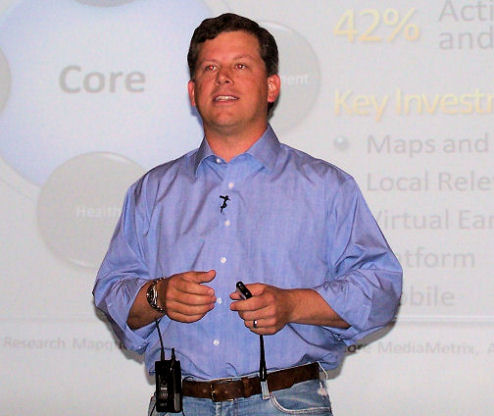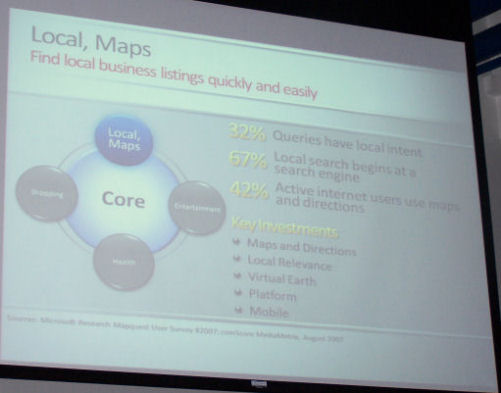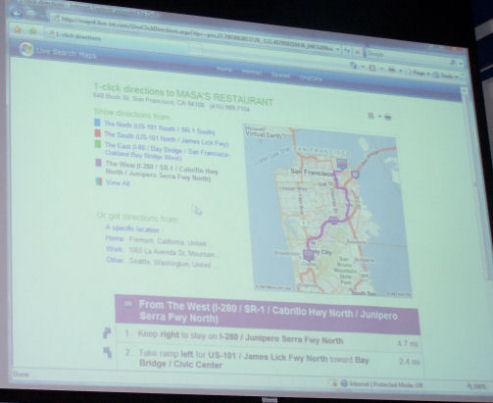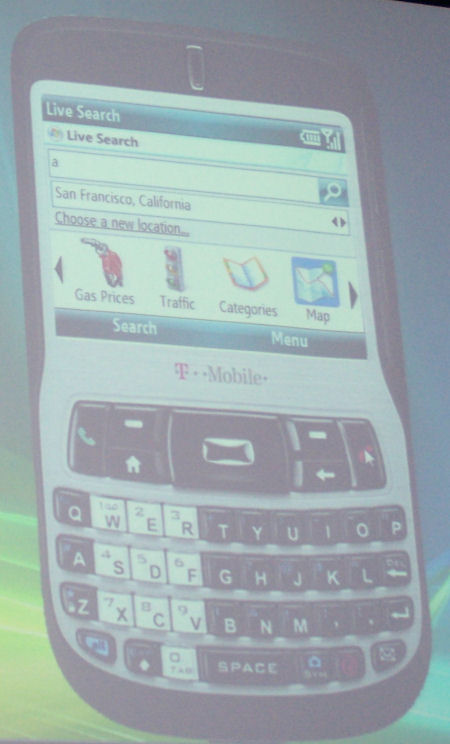Today’s post will cover the Local, Maps and Mobile search presentation made by Microsoft at the Searchification event on September 26, 2007. We have also written a post about the Core Improvements in Live Search that you can also read.
The presentation was made by Eric Jorgensen, a 13 year veteran of Microsoft:
 |
One of the first things that Eric spoke about was Local Search, and the prevalent nature of local searches:
 |
As you can see, the data shows that local search queries make up a huge percentage of total search. For that reason, Microsoft is investing heavily in its local search product offerings. Here are some of the key investments they have made:
- Microsoft is striving for clear product leadership in maps and driving directions. To aid in this, they have assembled a database with 50M exact business latitude and longitude codes. They are striving to provide the simplest and most intuitive driving directions, and the most accurate geocoding and relevance. Here is a look at the new interface:
 |
One of the coolest things that they are doing with this is that they are integrating real-time traffic information onto the map. Using color coding, you can see where the traffic jams are, and you can get alternate directions to get you around those jams. That was pretty cool functionality.
Microsoft’s Virtual Earth was already innovative, but they are working on expanding its functionality, and depth of coverage at a rapid pace. They currently have built 3D maps for 150 cities, and are looking to have 500 completed before the end of this year.
Microsoft is also offering a powerful B2B Map Platform. Their stated objective is to become the leading location platform on the web. Currently, this is in use on over 1300 major web sites. Only Mapquest has more, and they are just a little bit ahead of Microsoft at this point. They are already seeing 1.9 Billion transactions per month through this platform.
Next up was the mobile search product. Microsoft sees mobile search as enabling the next generation of location-based services. They are working on operator partnerships and have on in place with Sprint and Orange in Europe.
One nice thing is if you have searched for a movie theater, and then search for sushi, you will get the most relevant results close to the theater. On a Sprint phone, or a phone with Bluetooth GPS, the results will provide turn by turn directions. You can also get imagery of the location, so you can see what it looks like, right in your phone.
Microsoft also offers to integrate voice-activated search powered by TellMe. This is an awesome functionality to have because it eliminates all the hassles with typing on your phone when you want to do a quick search. The catch, of course, is how high the quality will be in processing the voice commands.
They will also be offering 1 click directions for any location. What this will do is show the directions from all major arteries, so you don’t have to enter in a starting address. This will come in really handy as it again lowers the amount of typing you need to do:
 |
Eric felt like there were 3 reasons why they have done so well in recent reviews of mobile search products:
- Strength of the UI
- Mobile search functionality
- Voice Activated searching, using the TellMe technology
All in all, pretty interesting stuff. I think it’s smart for Microsoft to focus on establishing footholds in various vertical search areas. Combined with an increase in core web search relevance, it gives them a chance to increase their market share.
